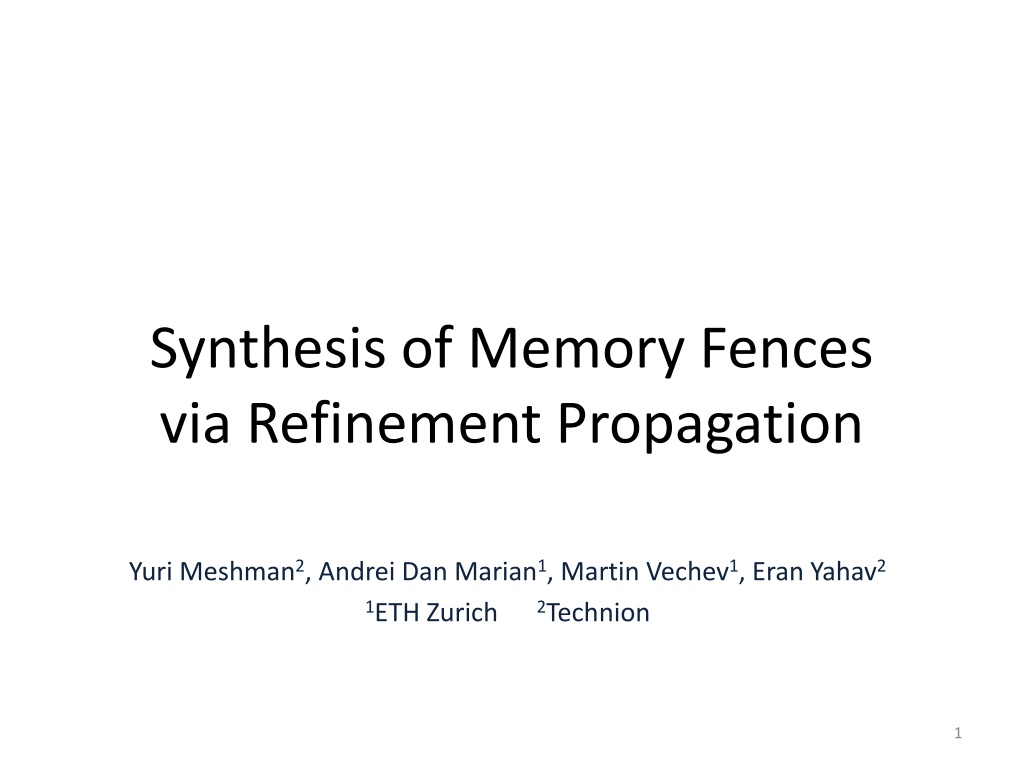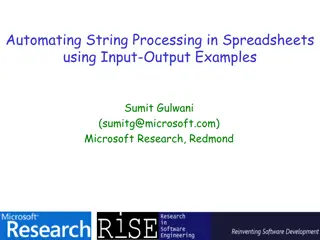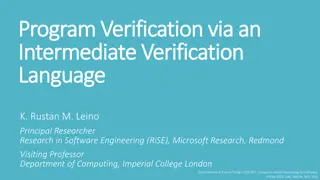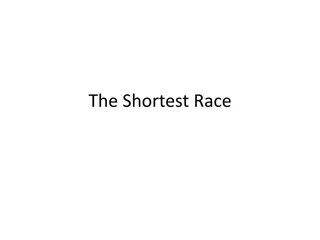Memory Fence Synthesis and Algorithm Verification
Abstract interpretation is utilized for sequential consistency in memory fence placement. The correctness of algorithms, such as Dekker's Algorithm, is verified by synthesizing minimal fence placements. The goal is to use existing tools to ensure the mutual exclusion of critical sections effectively.
Download Presentation

Please find below an Image/Link to download the presentation.
The content on the website is provided AS IS for your information and personal use only. It may not be sold, licensed, or shared on other websites without obtaining consent from the author. Download presentation by click this link. If you encounter any issues during the download, it is possible that the publisher has removed the file from their server.
E N D
Presentation Transcript
Synthesis of Memory Fences via Refinement Propagation Yuri Meshman2, Andrei Dan Marian1, Martin Vechev1, Eran Yahav2 1ETH Zurich 2Technion 1
Dekkers Algorithm initial: Flag0= false, Flag1 = false, Turn = 0 Thread 1: Thread 0: Flag0 := true while Flag1 = true { ifTurn 0 { Flag0 := false whileTurn 0 { } Flag0 := true } } // critical section Turn := 1 Flag0 := false Flag1 := true while Flag0 = true { ifTurn 1 { Flag1 := false whileTurn 1 { } Flag1 := true } } // critical section Turn := 0 Flag1 := false spec: mutual exclusion over critical section sequential consistency Yes No relaxed model x86 TSO 2
Correct Dekker Algorithm initial: Flag0 = false, Flag1 = false, Turn = 0 Thread 0: Flag0 := true fence while Flag1 = true { ifTurn 0 { Flag0 := false whileTurn 0 { } Flag0 := true fence } } // critical section Turn := 1 Flag0 := false Thread 1: Flag1 := true fence while Flag0 = true { ifTurn 1 { Flag1 := false whileTurn 1 { } Flag1 := true fence } } // critical section Turn := 0 Flag1 := false spec: mutual exclusion over critical section Yes relaxed model x86 TSO Potential fence locations 3
Goal Verify correctness of algorithms Synthesize minimal fence placements Use existing tools - concurinterproc 4
Abstract Interpretation using Numerical Domains for Sequential Consistency initial: Flag0 = false, Flag1 = false, Turn = 0 Thread 1: 0:/*init*/ 1: Flag1 := true 2: while Flag0 = true { 3: ifTurn 1 { 4: Flag1 := false 5: whileTurn 1 { } 6: Flag1 := true 7: } 8: } 9: // critical section A: Turn := 0 B: Flag1 := false Thread 0: 0:/*init*/ 1:flag0 := true 2: while Flag1 = true { 3: ifTurn 0 { 4: Flag0 := false 5: whileTurn 0 { } 6: Flag0 := true 7: } 8:} 9:// critical section A: Turn := 1 B: Flag0 := false (0,0) { Turn = 0; Flag1 = 0; Flag0 = 0 } (9,9) { bottom } (2,2) { Flag1 1 = 0; Flag0 1 = 0; -Turn + Flag1 >= 0; Turn >= 0 } (2,9) { Flag1 - 1 = 0; Flag0 - 1 = 0; } //line number indicate state at the end of the line (i.e. after executing) 5
Buffered Relaxed Memory Model Flush (by memory subsystem) store fence (Turn, 1) ... Thread 0 Main Memory (Turn, 0) ... Thread 1 load 6
Our Approach: Overview Program P Program P with Fences Specification S PAFI Memory Model M P satisfies the specification S under M PAFI Propagation of Abstraction for Fence Inference 7
Fence Inference with Abstraction Refinement Program P Fence Inference fixed point SC Specification S Refinement Propagation PM P translate analyzer Abstraction Refinement Memory Model M Challenge: when should we add fences, when should we refine abstraction? 8
Translation: Construction of PTSO Translation items for process t0: buffer size limit: k buffer location i : varit0, valit0 buffer dynamic size: cnt_t0 (var3t0, val3t0) (var2t0, val2t0) (var1t0, val1t0) cnt_t0 load a = Y if cnt_t0 > k - 1 and varkt0 == Y a = valkt0; : elseif cnt_t0 > 0 and var1t0 == Y a = val1t0; else a = Y; 9
Translation: Construction of PTSO Translation items for process t0: buffer size limit: k buffer location i : varit0, valit0 buffer dynamic size: cnt_t0 (var3t0, val3t0) (var2t0, val2t0) (var1t0, val1t0) cnt_t0 store Y = a if cnt_t0 >= k halt; //overflow cnt_t0 = cnt_t0 + 1; if cnt_t0 < 2 var1t0 = Y ; val1t0 = a; : elseif cnt_t0 < k + 1 varkt0 = Y ; valkt0 = a; 10
Translation Challenge - Flush while nondet yield; if cnt_t0 > 0 if var1t0 == X X = val1t0; elseif var1t0 == Y Y = val1t0; var1t0 var3t0 var2t0 Y X 1 3 Main Memory val1t0 cnt_t0 if cnt_t0 > 1 var1t0 = var2t0; val1t0 = val2t0; if cnt_t0 > 2 var2t0 = var3t0; val2t0 = val3t0; cnt_t0 = cnt_t0 - 1; X /* due to the non deterministic loop at this point we can t know if flush occurred or not.*/ 11
Why Flush Encoding is Challenging? The non deterministic flush captures two buffer states: a. A value is flushed -- buffer content moves one place (shifting) b. The value of X is not flushed We need a disjunction to represent both. For convex numerical domains supporting disjunction is expensive. flushed: non flushed: 3 3 3 1 cnt_t0=1 cnt_t0=2 join 3 [1,3] cnt_t0=[1,2] 12
Abstraction Refinement We will use Refinement Placement -- utilize logico-numerical domains: o Auxilary boolean flags o Similar to trace partitioning. o Supported by our SC verifier ConcurInterproc flushed: non flushed: 3 3 3 1 cnt_t0=1 cnt_t0=2 3 1 ? , cnt_t0=2 3 3 ? cnt_t0=1 13
Partial refinement placement 1. Each boolean variable splits the state verification complexity growth exponential (in flush complexity). 2. Partial refinement(booleans) placement may safice We want a minimal placement that will enable verification. ? = ??1,??2, 14
Two-dimensional exponential search 1. 2. Search a two dimensional domain. Search space exponential in number of fences and in number of refinement placements We will learn from verified and failed attempts We would like a minimal refinement We would like a minimal fence placement 15
Example Flag0 := true fence while Flag1 = true { ifTurn 0 { Flag0 := false fence whileTurn 0 { } Flag0 := true fence } } // critical section Turn := 1 fence Flag0 := false fence 5 potential fence locations 8 potential refinement locations 16
Example Placement implication Removed fence Fence Refinement 17
Example ? 18
Abstraction Propagation f3,r3 f3,r3 f1,r1 f2,r2 f1,r1 f2,r2 propagation of: program correctness + abstraction refinements Legend: means the program is about to be explored means the program was not yet explored means the program has been explored means the program need not be explored further means is a successful abstraction refinement used to verify program is a suggestion to prove program with a combined abstraction refinement 19
Prototype Implementation Implementation in Python ConcurInterproc Z3 checking final state satisfies specification Experiments: Intel(R) Xeon(R) 2.13 GHz server with 250 GB RAM 20
Benchmarks 15 concurrent algorithms Mutual exclusion algorithms Unbounded array-based concurrent work-stealing queue: Chase-Lev WSQ 8 infinite state Safety specifications mutual exclusion and reachability invariants Queue coherence invariants 21
Example of Results : PC1 9 possible fences 27 possible locations for refinement placement BFS explore various boolean placements for full fenced placement for 3:30 hours DFS verifies 5 fence placements in under 5 mins state explosion leads to exploring failing placements for the rest of the time Propagation finds that a single fence is needed 22
Summary Verification and Fence Synthesis via refinement propagation Using translation to encode Relaxed Memory semantics into code. Abstraction refinement using booleans Two dimensional search Learning from failed and successful verifications to guide the search. Thank you: Questions? Partly supported by SNF grant on practical synthesis for concurrent systems and ISF grant # 965/10 25
TSO 4h f 0 0 0 algorithm (f, r) abp (2,17) 1h f 0 0 0 2h f 0 0 0 r 0 0 0 r 0 0 0 r 0 0 0 prop bfs dfs concloop (4,14) prop bfs dfs 2 2 2 4 8 4 2 2 2 4 4 4 2 2 2 4 4 4 kessel (6,12) prop bfs dfs 5 5 5 3 3 6 4 5 5 0 1 6 4 5 5 0 1 6 loop2-TLM (6,21) prop bfs dfs 6 5 5 10 5 10 5 10 2 8 5 5 8 8 4 14 5 7 pc1 (9,27) prop bfs dfs 3 9 5 3 3 9 3 9 5 3 2 9 1 14 8 5 6 9 peterson (6,23) prop bfs dfs 5 6 4 2 0 7 4 5 4 3 5 7 4 5 4 3 2 7 pgsql (8,23) prop bfs dfs 5 8 8 7 4 8 5 8 8 7 3 8 5 8 8 7 1 8 27
PSO 4h f 0 0 0 algorithm (f, r) abp (2,17) 1h f 0 0 0 2h f 0 0 0 r 0 0 0 r 0 0 0 r 0 0 0 prop bfs dfs concloop (4,14) prop bfs dfs 2 2 2 4 8 4 2 2 2 4 4 4 2 2 2 4 4 4 dekker (10,34) our bfs dfs 10 0 10 8 10 7 10 6 9 10 9 10 9 10 9 0 8 0 kessel (6,12) prop bfs dfs 3 5 4 0 2 7 3 4 4 0 7 7 3 4 4 0 1 7 loop2-TLM (6,21) prop bfs dfs 4 5 5 5 2 6 4 4 4 10 4 10 5 4 4 4 5 3 pc1 (9,27) prop bfs dfs 2 9 1 0 2 0 2 9 1 0 2 0 1 8 1 3 6 0 pgsql (8,23) prop bfs dfs 4 8 7 0 2 8 4 8 7 0 1 8 4 7 7 0 1 8 28
Numerical analysis is not monotonic Our assumption: smaller refinement placement is easier to verify. Nature of abstraction: the assumption could be false. 29
Related work Memorax (TACAS12-13, SAS12) 30
Related work Muskteer - Don t sit on the fence (CAV14) 31
Related work Software verification for weak memory via program transformation (ESOP13) 32
Related work SAS13 33

























